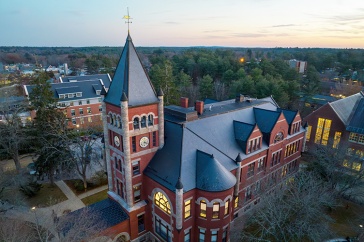
When Kaitlyn Mastacouris and Ari Nadeau were faced with having to choose a career path, being challenged and making a difference in the community were at the top of their list. Chance encounters when they were young led both women to choose to study American Sign Language-English Interpreting.
Mastacouris was introduced to American Sign Language (ASL) as a kindergartner when she learned to sign the alphabet.
“I was really fascinated by it,” says Mastacouris. “There was a Deaf boy who went to our school, and I watched he and his interpreter go back and forth signing and I thought, ‘I want to do that.’”
Her mother encouraged her interest by buying books that taught kids common words in ASL. As the year passed, Mastacouris forgot about the books and was swept into the day-to-day life of a student.
After graduating from Manchester’s Central High School in 2010, she enrolled at Manchester Community College and, when faced with a language requirement, she recalled her earlier curiosity and chose ASL as her language. She transferred to the University of New Hampshire’s Manchester campus where she knew they had a highly respected ASL/English Interpreting program, and the first of its kind to be accredited in the country.
“I had my heart set on it,” says Mastacouris.
Nadeau’s first experience with ASL was in the 8th grade when she learned to sign the song “I Can See Clearly Now” by Johnny Nash. Fascinated by the experience, she took all of the ASL courses offered at Manchester’s Memorial High School. She graduated in 2014 and applied to UNH Manchester’s ASL/English Interpreting program.
“The program is top quality and it is right next door,” says Nadeau.
Mastacouris and Nadeau, now seniors at UNH Manchester, say the ASL/English Interpreting program has certainly provided the challenge they’d hoped for while also preparing them for a rewarding career.
“At UNH, it’s you and the Deaf professor. There are no interpreters in the classroom, so you have to work together to figure it out. It’s such a great way to learn,” says Mastacouris. “There are no lectures. You can’t take notes because you have to maintain eye contact. You must have both feet in and be fully invested in this experience.”
Integration with the Deaf community inside and outside the classroom is also a unique feature of UNH Manchester’s ASL/English Interpreting program.
“It’s a good way to experience how different people sign,” says Nadeau. “Just like a hearing person has accents, Deaf people have variations in how they sign.”
Laurie Shaffer, a lecturer in the program, said the college is very lucky to have such a strong presence in both the Deaf and hearing communities.
“The program makes such an effort to be sure to include the Deaf community. The program’s board is 50 percent Deaf,” Shaffer says. “The community is very invested in us, too.”
A full-year field experience is also a unique feature of the program. Seniors are paired with a nationally certified mentor and use their interpretation and ASL skills within organizations throughout the state.
Last fall Mastacouris and Nadeau were assigned to Krempels Center, a community program in Portsmouth, N.H., for adults living with acquired brain injury. They were paired with Claire (whose name has been changed to protect her privacy), a member of the community who is Deaf but had been communicating via lip reading because the Center did not have interpreters available.
“It is very hard to understand when people are speaking,” says Claire. “When the interpreters came, I was so happy. I’m more comfortable joining group activities.”
Lisa Couture ‘94, Krempels Center executive director, was pleased to have interpreting students join the Center.
“We have a very strong relationship with UNH. We typically have 60 to 70 student interns at the Center each year,” says Couture. “This is the first time we’ve had ASL/English interpreters.”
Couture is grateful for the dimension the interpreters have added to the community.
“It feels even more inclusive,” says Couture. “We have a very welcoming community for any brain injury survivor walking in the door. Having the interpreting students with us creates an even deeper level of inclusivity. It’s very powerful.”
Mastacouris and Nadeau work as a team to provide interpreting for Claire. They take turns interpreting but also support and teach one another. Claire also helps clarify when they run into questions about how to sign a specific phrase or word.
“Claire is such an encouraging person,” says Mastacouris. “I know if I make a little mistake she’s so happy to help me and show me the correct sign.”
“It’s a fantastic teaching and learning experience that is really meaningful for Claire,” says Couture. “Not only is it helping her feel part of the community at Krempels Center, but it also gives her a sense of purpose to support these students as part of their learning experience.”
In addition to Krempels Center, Mastacouris has also had experience shadowing an interpreter at job interviews, at nursing homes during physical therapy appointments and other medical appointments. Nadeau has shadowed an interpreter at a local school for the Deaf, AA meetings and at medical appointments.
Both women will graduate in May 2018 but hope to continue at the Center as volunteers through the summer to help transition Claire to the new students who come into the field experience. They also anticipate taking the state screening and national licensure exams in the near future.
Interested in learning more about Sign Language Interpretation? Learn more about the ASL/English Interpreting program.

















































